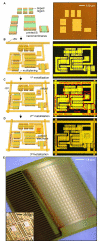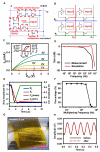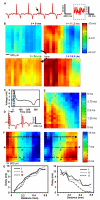A conformal, bio-interfaced class of silicon electronics for mapping cardiac electrophysiology
- PMID: 20375008
- PMCID: PMC3039774
- DOI: 10.1126/scitranslmed.3000738
A conformal, bio-interfaced class of silicon electronics for mapping cardiac electrophysiology
Abstract
In all current implantable medical devices such as pacemakers, deep brain stimulators, and epilepsy treatment devices, each electrode is independently connected to separate control systems. The ability of these devices to sample and stimulate tissues is hindered by this configuration and by the rigid, planar nature of the electronics and the electrode-tissue interfaces. Here, we report the development of a class of mechanically flexible silicon electronics for multiplexed measurement of signals in an intimate, conformal integrated mode on the dynamic, three-dimensional surfaces of soft tissues in the human body. We demonstrate this technology in sensor systems composed of 2016 silicon nanomembrane transistors configured to record electrical activity directly from the curved, wet surface of a beating porcine heart in vivo. The devices sample with simultaneous submillimeter and submillisecond resolution through 288 amplified and multiplexed channels. We use this system to map the spread of spontaneous and paced ventricular depolarization in real time, at high resolution, on the epicardial surface in a porcine animal model. This demonstration is one example of many possible uses of this technology in minimally invasive medical devices.
Figures




References
-
- Gelinck GH, Huitema HEA, Veenendaal E, Cantatore E, Schrijnemakers L, Putten JBPH, Geuns TCT, Beenhakkers M, Giesbers JB, Huisman B-H, Meijer EJ, Benito EM, Touwslager FJ, Marsman AW, Rens BJE, Leeuw DM. Flexible active-matrix displays and shift registers based on solution-processed organic transistors. Nat. Mater. 2004;3:106–110. - PubMed
-
- Cantatore E, Geuns TCT, Gelinck GH, Veenendaal E, Gruijthuijsen AFA, Schrijnemakers L, Drews S, Leeuw DM. A 13.56-MHz RFID system based on organic transponders. IEEE J. Solid-St. Circ. 2007;42:84–92.
-
- Baca AJ, Ahn J-H, Sun Y, Meitl MA, Menard E, Kim H-S, Choi WM, Kim D-H, Huang Y, Rogers JA. Semiconductor wires and ribbons for high-performance flexible electronics. Angew. Chem. Int. Ed. 2008;47:5524–5542. - PubMed
-
- Khang DY, Jiang H, Huang Y, Rogers JA. A stretchable form of single-crystal silicon for high-performance electronics on rubber substrates. Science. 2006;311:208–212. - PubMed
-
- Kim D-H, Ahn J-H, Choi WM, Kim H-S, Kim T-H, Song J, Huang YY, Liu Z, Lu C, Rogers JA. Stretchable and foldable silicon integrated circuits. Science. 2008;320:507–511. - PubMed
Publication types
MeSH terms
Substances
Grants and funding
LinkOut - more resources
Full Text Sources
Other Literature Sources

